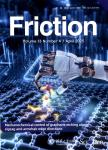版权所有:内蒙古大学图书馆 技术提供:维普资讯• 智图
内蒙古自治区呼和浩特市赛罕区大学西街235号 邮编: 010021

作者机构:State Key Laboratory of Solidification ProcessingCenter of Advanced Lubrication and Seal MaterialsNorthwestern Polytechnical UniversityXi’an 710072China Petro China Lanzhou Lubricating Oil R&D InstituteLanzhou 730060China Key Laboratory of Education Ministry for Modern Design and Rotor-Bearing SystemXi'an Jiaotong UniversityXi'an 710049China
出 版 物:《Friction》 (摩擦(英文版))
年 卷 期:2021年第9卷第6期
页 面:1436-1449页
核心收录:
学科分类:07[理学] 070205[理学-凝聚态物理] 08[工学] 080203[工学-机械设计及理论] 080501[工学-材料物理与化学] 0805[工学-材料科学与工程(可授工学、理学学位)] 0802[工学-机械工程] 0702[理学-物理学]
基 金:This work was supported by the Fundamental Research Funds for the Central Universities(31020195C001,3102019QD0413,3102019ZD0403) The suggestions from Q.Jane Wang at Northwestern University are appreciated.Hongxing Wu also acknowledges the scholarship support from the China Scholarship Council(CSC,No.201606280181)
主 题:nanoparticle lubrication oil film thickness flow pattern particle aggregation
摘 要:The lubrication effectiveness of MoS_(2) nanoparticles as an oil additive remains unclear,restricting its application in industry to reduce *** goal of this work was to explore the lubrication mechanism of MoS_(2) nanoparticles as an oil *** this study,the oil film thickness behaviors of MoS_(2) nanoparticles in poly-alpha olefin(PAO4)base oil,PAO4 with 3 wt%dispersant(polyisobutyleneamine succinimide,PIBS),and 0W20 engine oil were investigated using an elastohydrodynamic lubrication(EHL)testing *** the EHL tests,the flow patterns around the contact area and the tribofilm covering rate on contact area were studied using optical microscopy to understand the lubrication *** results indicate that both the dispersant and nanoparticle aggregation significantly affected the oil film *** expected oil film thickness increase in the case of 0.1 wt%MoS_(2) in PAO4 base oil was obtained,with an increase from 30 to 60 nm over 15 min at a velocity of 50 mm/*** pattern analysis revealed the formation of particle aggregation on the rolling path when lubricated with 0.1 wt%MoS_(2),which is associated with a tribofilm coverage rate of 41.5%on the contact ***,an oil film thickness increase and particle aggregation were not observed during the tests with 0.1 wt%MoS_(2) blended with 3 wt%PIBS as the dispersant in PAO4 base oil,and for 0.75 wt%MoS_(2) in 0W20 engine *** results suggest that nanoparticles responsible for tribofilm formation originated from aggregates,but not the well-dispersed nanoparticles in point *** understanding should aid the advancement of novel lubricant additive design.